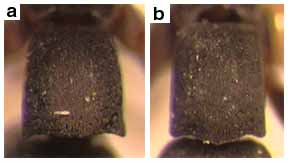
| Genus List | Species List |
The last revison of this genus was Brown (1975). Brown summarized the biology of Platythyrea as follows:
Platythyrea is known only from scattered observations. Most of the species are known from stray workers or small colonies in rotten wood, or from beetle burrows, hollow twigs, and similar cavities in standing live or fallen dead trees. Many of the species can be found on logs or tree trunks at forest edges in the tropics, running very rapidly over bark or leaves of trees. I have found P. sinuata running with marvellous speed and grace over leaves in living tree foliage more than 15 meters above the ground...Termites seem to make up a large part of the diet of a number of Platythyrea species the world around... The sting of Platythyrea is more severe, in my experience, than that of most ponerines, size for size. A sting of P. sinuata (in Panama) on my hand caused a deep throbbing pain that lasted most of one day, and left lingering tenderness for another day.
Key to Platythyrea Species Known from Costa Rica, Based on Workers
10a. Mandible with a basal sulcus on outer surface near mandibular insertion: 100
10b. Mandible lacking basal sulcus: pilosula

100a. Masticatory margin of mandible straight, lacking teeth: 200
100b. Masticatory margin of mandible serrate, with distinct teeth: prizo

200a. Petiole in dorsal view relatively short, less than 0.85mm: punctata
200b. Petiole in dorsal view relatively longer, greater than 0.85mm: sinuata

Figure 6 from Brown (1975), showing scatterplot of petiole length vs. width for the punctata complex: (resolution low, high).
Brown, W. L., Jr. 1975. Contributions toward a reclassification of the Formicidae. V. Ponerinae, tribes Platythyreini, Cerapachyini, Cylindromyrmecini, Acanthostichini, and Aenictogitini. Search Agri., Entomol. (Ithaca) 5:1-115.
Page author:
John T. Longino, The Evergreen State College, Olympia WA 98505 USA.longinoj@evergreen.edu